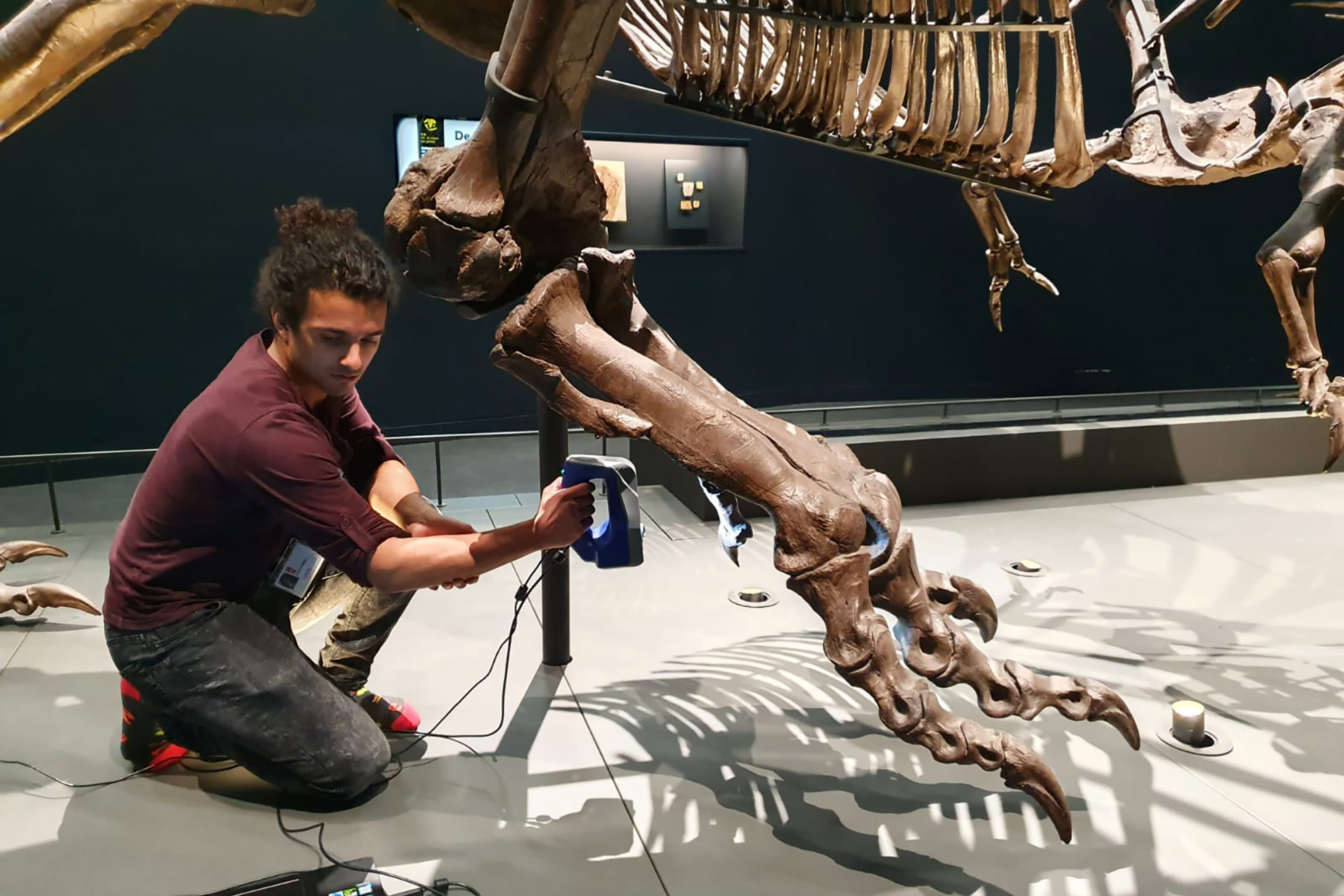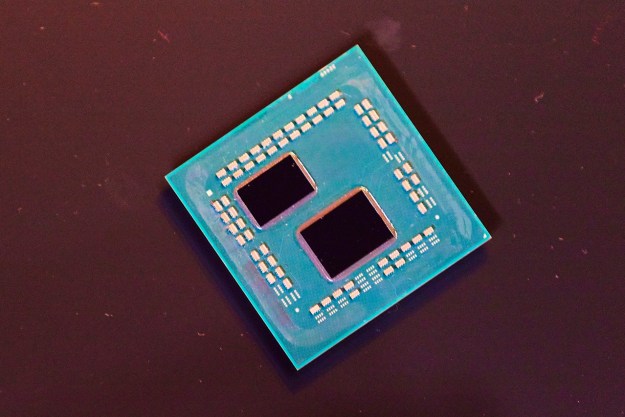In Jurassic Park, cloning a Tyrannosaurus rex involved the discovery of dinosaur blood fossilized in amber, a whole lot of genetic engineering, and a willful disregard for the health and wellbeing of Jeff Goldblum. For a team of researchers at the Naturalis Biodiversity Center in Leiden, the Netherlands, copying a T. rex took some state-of-the-art laser scanning technology, a giant 3D printer, a just-as-sizable postage bill, almost 45 million square millimeters of acrylic paint, and a group of experts wishing to push the boundaries of additive manufacturing.

Let’s back up. A little under a decade ago, in 2013, a group of paleontologists from the Netherlands discovered a beautifully preserved skeleton of an adult T. rex on a dig in Montana. With around 75% to 80% of its bone volume intact, this was the third most complete T. rex ever discovered.
They called their 11,000 pound, 42-foot long, 66 million-year-old specimen “Trix.”
Trix is now on display at the Naturalis Biodiversity Center (or, at least, it will be again in May when the museum reopens again following Covid). It is one of only a couple of Tyrannosaurus specimens on permanent exhibition on mainland Europe.

T. rex skeletons are, perhaps unsurprisingly, rare. Since the first one was discovered in 1902 — in the excellently named Hell Creek, Montana — only 32 adult T. rex fossils have been discovered in total. Ever. That’s out of a population of what scientists now believe was 2.5 billion over the couple of million years the species existed. To put it another way, out of every 80 million T. rexes thought to have ever lived, just one has been unearthed.
When a new dinosaur museum in Japan — set to open in Nagasaki in October 2021 — began pulling together its collection, it could have waited to try and get its hands on a genuine skeleton. However, the chances of this are vanishingly small. Fortunately, Nagasaki happened to be twinned with Leiden. As a result, the team behind the Nagasaki museum reached out to Naturalis to ask if they would be willing to manufacture a 3D reproduction of Trix to sit in pride of place at the new venue. The Naturalis team said that they would.
“This was quite a challenge, but we were very happy to accept,” Hanneke Jacobs, project manager at Dinosaurs at Naturalis, told Digital Trends.
Building the tyrant king
The quandary of reproducing Trix was made slightly easier by some previous work that had been carried out by the paleontologists who discovered the skeleton in 2013. As a way to preserve it, the team had 3D-scanned many of the bones at high resolution. This archive of bones was augmented with new scans of certain parts — such as the foot bones, jaw, and skull — by anatomist Pasha van Bijlert. The scanning process was carried out using various Artec 3D scanners, including the Artec Eva, Artec Spider, and Artec Leo. On a computer, the Naturalis team then manipulated the skeleton so that it appeared in the “attacking” pose the Nagasaki museum had requested.

However, building a digital copy of a T. rex skeleton was only step one of the process. It’s the difference between Apple CEO Tim Cook seeing a CAD drawing of the next iPhone and a customer holding the finished product in her hand. Printing was a whole other ball game.
“Printing an entire T. rex is a monster job,” Jacobs said — pun possibly intended. “It took almost a year on two giant Builder Extreme 3D printers and eight Ultimaker 2+ printers to print all the 320-plus bones. Some of the bones were still too large to fit into the printer in its entirety, so those had to be digitally cut to fit.”
The process of printing the bones using PLA was a time-consuming stress headache. “Some of the prints took almost two weeks to finish,” she continued. “Because the office was closed during the weekends due to COVID, it could be quite nerve-wracking to go and have a look if everything went alright on Mondays.”

Once the printing had been completed, it was onto the next stage of the process. For one thing, the pieces had to be painted: a process carried out by hand to give the white 3D-printed material appropriately aged coloring. Because the “bones” were going to be shipped to Japan, the researchers didn’t fully assemble the finished skeleton. However, they did glue together the hundreds of separate prints into 50 larger pieces that could then be joined together. Each of these segments had to be mounted on steel frame parts, which will connect like an enormous Lego set.
The biggest challenge, Jacobs said, was timing. “It had never been done before,” she said. “We did not know if the calculations were correct and how long it would all take, especially the post-processing of the prints and the production of the frame. Luckily we had a very skilled team that was very flexible and good at troubleshooting.”
Finally, the project was completed and Trix’s twin shipped off to Japan. It will now be installed in its new home ready for the Dinosaur Museum’s opening on October 29.
Print your own (cat-sized) T. rex
In October last year, the skeleton of a T. rex, named “Stan,” was sold at Christie’s auction for a mind-boggling $31.8 million. (To date, no buyer has been announced.) For the overwhelming majority of readers, having this kind of cash to drop on a dinosaur specimen is a highly unlikely proposition.
So would it be possible to 3D-print a T. rex skeleton on a budget? To paraphrase Justin Timberlake’s Sean Parker in The Social Network: A T. rex skeleton in some rich dude’s man-cave isn’t cool. You know what’s cool? A T. rex skeleton in a 20-something’s studio apartment.
That may also be a good thing when it comes to the sale of dino skeletons. To paleontologists, the idea of a fossil becoming a curio in some billionaire’s fourth living room is a tragedy. It means losing access to a specimen that could help advance the ever-moving global research into the field.
“There is [a possibility],” said Jacobs. Unfortunately, she added, probably not on the full-scale that her team carried out. (“Or, [if you really do want that,] you have to talk to our CEO,” she laughed.)
But the corporate suits behind Jurassic Park didn’t give up when the original version of the park went horribly wrong, and resulted in the deaths of a bunch of people. They came back — in the storyline, at least — with Jurassic World. In other words, these things are all about persistence. And, in this case, compromise.
“If you have a 3D printer yourself, you can print your own cat-sized T.Rex via the manual that Naturalis provides online,” Jacob noted. “There is also a 3D-print available of our Triceratops.”
This one won’t break the bank, either. “It will cost you approximately one roll of filament, some glue, and some patience I’d say,” she said.
That’s the kind of expense we can spare.
Editors' Recommendations
- Glasses-free 3D gaming can be amazing — but only if it’s done right
- Finally, you’ll soon be able to use 3D avatars on Teams calls
- AMD might deal a huge blow to Intel with new 3D V-Cache CPUs
- Acer launches eye-popping displays with built-in 3D tech
- AMD Ryzen 7 5800X3D scores are in, but don’t trust them yet




